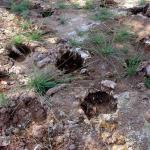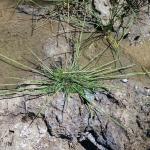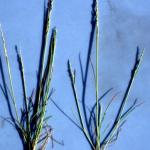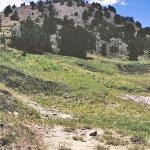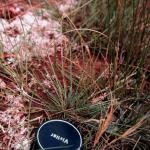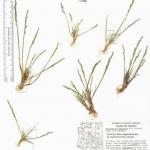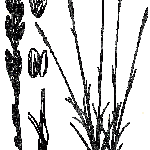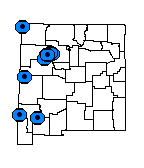Puccinellia parishii (Parish's Alkali Grass)
NONE
| USFWS | State of NM | USFS | BLM | Navajo Nation | State Rank | Global Rank | R-E-D Code | NMRPTC Status | Strategy Status |
|---|---|---|---|---|---|---|---|---|---|
| E | SEN | SEN | GP 4 | S1 | G2G3 | 1-2-1 | R | SS |
| Overall Conservation Status | Documented Threats | Actions Needed |
|---|---|---|
| WEAKLY CONSERVED | Water management/use. Livestock ranching/farming |
Population trend monitoring, document threat imapcts (grazing, drought) |
Dwarf annual with 1 to many stems; leaf blades about 1 mm broad, flat or involute, short; culms mostly 5-15 cm tall; panicle narrow, few-flowered, the branches erect-appressed; spikelets 4-6 mm long; glumes shorter than the first floret, broad, strongly nerved, scarious-margined; florets 4-6 per spikelet, disarticulating above the glumes; lemmas about 2 mm long, obtuse to truncate, scarious and somewhat erose at the tip, pubescent on the mid and lateral nerves nearly to the apex, and on the intermediate nerves about half way. Flowers May to June.
Puccinellia distans and P. airoides can grow in the same habitat, but they are perennials, have wider leaves, and lack pubescence on the lemma nerves. Poa annua is a small annual with pubescence on the lemma nerves, but the leaves are wider and boat-shaped at their tips.
New Mexico, Catron, Cibola, Grant, Hidalgo, McKinley, Sandoval, and San Juan counties; Texas, California, Arizona, and Colorado.
Alkaline springs, seeps, and seasonally wet areas that occur at the heads of drainages or on gentle slopes at 800-2,200 m (2,600-7,200 ft) range-wide. The species requires continuously damp soils during its late winter to spring growing period. It frequently grows with Distichlis stricta (salt grass), Sporobolus airoides (alkali sacaton), Carex spp. (sedges), Scirpus spp. (bulrushes), Juncus spp. (rushes), Eleocharis spp. (spike rushes), and Anemopsis californica (yerba mansa).
This species was proposed for Federal listing as endangered on March 28, 1994 (59 FR 14378), but the proposal was withdrawn on September 25, 1998 (63 FR 51329) due to the discovery of additional populations and a re-evaluation of threats to the species. It is known from 30 sites range-wide, 17 in New Mexico.
Puccinellia parishii requires wet alkaline soils; activities that divert or dry up springs or seeps will destroy its habitat. It can persist at springs that have been severely impacted by livestock grazing and trampling.
Hitchcock, A.S. 1928. New species of grasses from the United States. Proceedings of the Biological Society of Washington 41:157-164.
*Hitchcock, A.S. and A. Chase. 1951. Manual of the grasses of the United States, 2nd edition. U.S. Department of Agriculture Miscellaneous Publication No. 200.
U.S. Fish and Wildlife Service. 1998. Endangered and threatened wildlife and plants; withdrawal of proposed rule to list the plant Puccinellia parishii (Parish's alkali grass) as endangered. Federal Register 63:51329-51332.
For distribution maps and more information, visit Natural Heritage New Mexico

